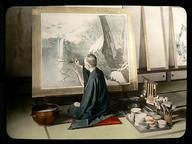Quiz Answer Key and Fun Facts
1. This 'M' term describes any large stone used to make dolmens (two large upright stones capped by a lintel stone across the top) such as the ones found at Stonehenge. What is this term which is derived from the Greek for 'large stone'?
2. Another very common 'M' term, this one describes a large painting done directly on a wall. A very popular form during the early Renaissance, when frescoes were frequently executed on the walls of churches, this sort of work was also popular amongst the post-revolutionary Mexican artists of the 20th century. Which 'M' term are we looking for here?
3. This term does not just describe a simple sketch, but an elaborate preliminary drawing or painting of a larger planned work meant to be shown to a patron. Which of the following terms best describes such a work?
4. We'll do a little Arabic now...for a change of pace. This architectural term describes a slender tower which rises above the surrounding structures in a Muslim city. From the balconies on these towers the faithful are called to prayer...but what are these towers called?
5. This term was coined by Italian Futurist painter de Chirico in 1917 to describe some of his bizarre paintings. Which term did he use?
6. The term 'merz' was self-coined to describe the works of which famed Dada artist?
7. Which of these terms describes a stick with padded end that is placed upon a canvas in such a way that her/his painting arm can rest and remain steady?
8. True or false: The term 'mannequin', employed in the modern sense to describe a life-sized figure used to model clothing, comes to us from the Middle Dutch for 'little man'.
9. What is the term used to describe a representation of the Virgin enthroned as Queen of Heaven, with Child in arms?
10. The terms 'Pentelic', 'Parian' and 'Carrara' are all associated with which 'M' of art?
Source: Author
thejazzkickazz
This quiz was reviewed by our editing team before going online.
Any errors found in FunTrivia content are routinely corrected through our feedback system.

